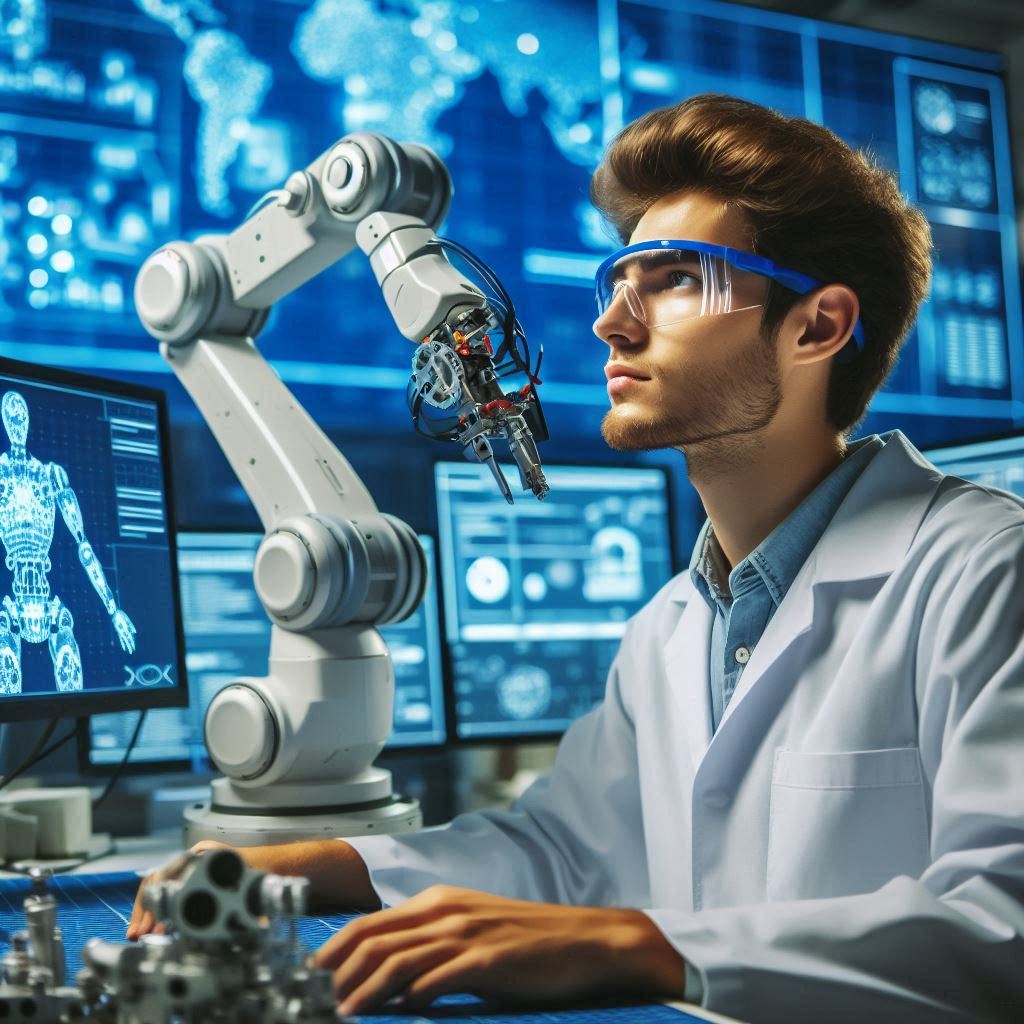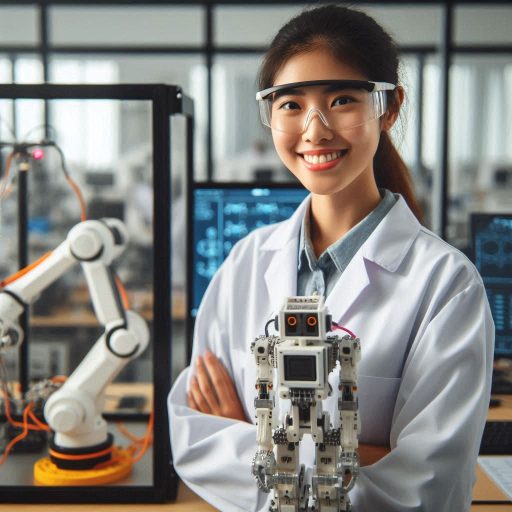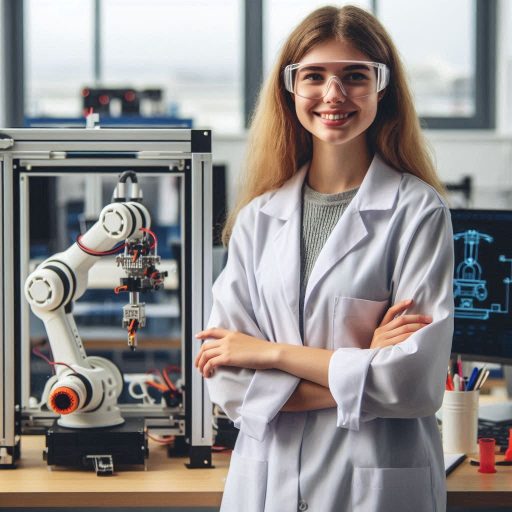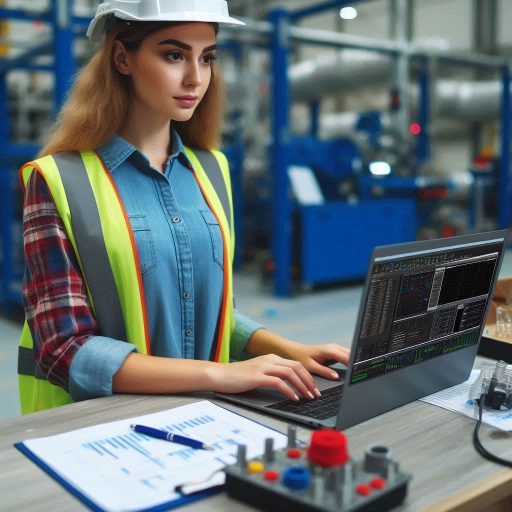Introduction
Robotics engineering is at the forefront of technological innovation, transforming how industries operate and solve complex challenges.
From healthcare and manufacturing to agriculture and logistics, robotics is making a significant impact across various sectors.
The Importance of Robotics in Various Industries
Robotics has become indispensable in numerous industries, offering solutions that enhance efficiency, precision, and safety.
In healthcare, robotic systems assist surgeons in performing minimally invasive procedures with unparalleled accuracy.
These systems reduce recovery times and improve patient outcomes.
In manufacturing, robotics is driving automation on assembly lines, increasing production speed, and ensuring consistent quality.
Robots also take on hazardous tasks, reducing the risk of injury to human workers.
Agriculture has also embraced robotics, with innovations in precision farming that optimize crop yields and reduce resource wastage.
These technologies enable farmers to monitor soil health, manage pests, and harvest crops more efficiently.
Project 1: Autonomous Drone Delivery System
Concept of Using Drones for Delivery Purposes
The concept of using drones for delivery purposes is revolutionizing logistics and supply chain management.
Autonomous drones are unmanned aerial vehicles designed to transport goods from one location to another without human intervention.
These drones use GPS, sensors, and advanced algorithms to navigate and deliver packages accurately and efficiently.
The rise of e-commerce has increased the demand for faster delivery solutions.
Drones offer a promising alternative to traditional delivery methods by providing rapid, direct transport to consumers‘ doorsteps.
They can bypass traffic congestion and reduce delivery times, enhancing customer satisfaction.
Benefits of Automation and Efficiency
Autonomous drone delivery systems bring numerous benefits to the delivery process.
Key advantages include:
- Speed: Drones can deliver packages much faster than traditional ground-based methods, especially in urban areas with heavy traffic.
- Cost Efficiency: Reducing reliance on human drivers and vehicles lowers operational costs for delivery companies.
- Reduced Carbon Footprint: Electric drones produce fewer emissions compared to gasoline-powered delivery trucks, contributing to environmental sustainability.
- Accessibility: Drones can reach remote or difficult-to-access areas where traditional delivery vehicles might struggle.
- Real-Time Tracking: Advanced tracking systems provide customers with accurate delivery updates and estimated arrival times.
Technology Used in Creating an Autonomous Drone Delivery System
Creating an autonomous drone delivery system involves integrating several advanced technologies.
These include:
- GPS and Navigation Systems: Drones use GPS for precise location tracking and route planning.
Navigation systems help them follow predefined paths and avoid obstacles. - Collision Avoidance Sensors: Equipped with sensors like LiDAR and cameras, drones can detect and avoid obstacles in their flight path, ensuring safe operation.
- Machine Learning Algorithms: Drones use these algorithms to learn from their environment and adapt to changing conditions.
This boosts flight efficiency and accuracy. - Battery Technology: Advanced battery systems provide the necessary power for drones to complete longer flights and multiple deliveries on a single charge.
- Communication Systems: Drones use wireless communication technologies to relay data and receive instructions from central control systems or operators.
- Autonomous Control Systems: These systems let drones operate independently. They make real-time decisions using sensor data and pre-programmed algorithms.
Autonomous drone delivery systems are poised to transform the logistics industry by offering faster, more efficient delivery solutions.
As technology continues to advance, these systems will become increasingly reliable and widespread, providing significant benefits to both businesses and consumers.
Cutting-edge technologies enable drones to navigate complex environments effectively.
They deliver packages accurately and support a more sustainable delivery model.
Read: How to Build a Strong CAD Technician Portfolio
Project 2: Robotic Exoskeleton for Rehabilitation
How Robotic Exoskeletons Aid in Rehabilitation
Robotic exoskeletons are revolutionizing the rehabilitation process for patients with mobility impairments.
These wearable devices support and enhance movement, providing vital assistance to individuals who struggle with physical limitations.
By integrating advanced robotics and biomechanics, exoskeletons enable patients to regain movement and strength more effectively than traditional methods.
These exoskeletons work by providing mechanical support and controlled movement.
They help patients perform exercises and movements that they may otherwise be unable to do.
This support not only aids in muscle reconditioning but also helps in rebuilding joint strength.
As a result, patients experience improved mobility and a faster recovery process.
Impact of Technology on Physical Therapy and Recovery
The integration of robotic exoskeletons into physical therapy has transformed patient rehabilitation in several significant ways:
- Enhanced Mobility: Exoskeletons assist patients in walking and performing movements despite limited physical abilities.
This support is crucial for patients recovering from spinal cord injuries or stroke.
The ability to walk again, even with assistance, helps in reactivating muscle groups and improving overall physical function. - Improved Therapy Outcomes: Exoskeletons provide precise, adjustable support, helping patients exercise with correct form and intensity.
This consistency is vital for effective rehabilitation, as it reduces the risk of improper technique and enhances the quality of therapy sessions.
The technology allows for personalized therapy adjustments based on real-time feedback and performance metrics. - Increased Motivation: Advanced technology often boosts patient engagement and motivation.
Robotic exoskeletons offer interactive and engaging rehabilitation experiences, which can make therapy sessions more enjoyable.
This increased motivation encourages patients to actively participate in their recovery, leading to better outcomes. - Data-Driven Insights: Exoskeletons are equipped with sensors and data collection tools that monitor patient movements and progress.
This data provides valuable insights for therapists, allowing them to tailor treatment plans to the specific needs of each patient.
The ability to track and analyze progress in real-time enhances the effectiveness of rehabilitation programs.
Examples of Successful Robotic Exoskeleton Projects
Several pioneering robotic exoskeleton projects have demonstrated significant benefits in healthcare:
- ReWalk Robotics: ReWalk Robotics has developed a robotic exoskeleton that helps individuals with spinal cord injuries regain the ability to walk.
This device is widely used in rehabilitation centers and has shown remarkable success in improving patients’ mobility and independence.
The ReWalk exoskeleton enables users to stand, walk, and even climb stairs, offering a new level of functional recovery. - Ekso Bionics: Ekso Bionics offers a range of robotic exoskeletons designed to assist patients with lower limb paralysis.
Their devices are utilized in clinical settings to support walking and rehabilitation.
Ekso exoskeletons enhance patients’ physical capabilities. They support gait training and daily activities.
They improve overall quality of life. - HAL (Hybrid Assistive Limb) by CYBERDYNE:CYBERDYNE‘s HAL exoskeleton offers advanced rehabilitation support.
It assists patients with neurological and orthopedic conditions.
This innovative technology offers personalized assistance, helping patients recover motor functions and improve their physical abilities.
HAL has received recognition for its impact on enhancing mobility and rehabilitation outcomes through its adaptive and responsive support mechanisms.
In essence, robotic exoskeletons are transforming the field of rehabilitation, offering substantial benefits for patients with mobility impairments.
By enhancing physical therapy and providing essential support, these devices play a crucial role in improving recovery outcomes.
Successful projects like ReWalk, Ekso Bionics, and HAL highlight the potential of robotic exoskeletons in advancing rehabilitation practices.
Technology evolves rapidly, driving significant changes in rehabilitation.
Innovations will increasingly reshape recovery and support individuals on their path to healing.
ful tools in the field of rehabilitation, offering patients new possibilities for recovery and improved quality of life.
The integration of technology in physical therapy continues to advance, providing innovative solutions to enhance patient care and outcomes.
Read: Best Online Courses for CAD Technician Training
Self-Driving Cars Technology
Advancements in Self-Driving Car Technology
Self-driving cars are leading the charge in automotive innovation, with rapid advancements transforming how we think about transportation.
These autonomous vehicles use a blend of cutting-edge technologies to navigate roads safely and efficiently.
Recent advancements in self-driving technology include:
- Advanced Sensors: Modern self-driving cars are equipped with high-resolution cameras, LIDAR, and radar.
These sensors create a detailed, 360-degree view of the vehicle’s surroundings, allowing it to detect obstacles, other vehicles, and pedestrians with high accuracy. - Sophisticated AI Algorithms: Artificial intelligence plays a critical role in autonomous driving.
Machine learning models interpret complex driving scenarios.
They analyze road signs, navigate intersections, and respond to unexpected events.
These algorithms help the vehicle make real-time decisions based on the data collected from its sensors. - Vehicle-to-Everything (V2X) Communication: Self-driving cars now use V2X technology to communicate with other vehicles and infrastructure.
This technology enables vehicles to share information about traffic conditions, road hazards, and signal changes, improving coordination and safety on the roads.
Potential Benefits of Autonomous Vehicles
The potential benefits of self-driving cars are substantial and could lead to transformative changes in transportation.
These benefits include:
- Enhanced Safety: One of the most significant advantages of autonomous vehicles is the potential reduction in traffic accidents caused by human error.
Self-driving cars use advanced sensors and AI to minimize risks, such as distracted or impaired driving, leading to fewer collisions and safer roads. - Increased Efficiency: Autonomous vehicles can optimize driving patterns, including speed and route selection.
This optimization can reduce traffic congestion, lower fuel consumption, and decrease travel times.
By communicating with traffic management systems, self-driving cars can adjust their behavior based on real-time traffic conditions. - Greater Accessibility: Self-driving cars increase mobility for people who cannot drive.
This includes the elderly, disabled, and those without a driver‘s license.
This enhanced accessibility can improve quality of life and provide greater independence for these individuals. - Cost Savings: Autonomous vehicles could lead to significant cost savings in several areas.
Self-driving cars increase mobility for people who cannot drive.
This includes the elderly, disabled, and those without a driver‘s license.
Shared autonomous vehicles could also reduce overall transportation expenses for users.
Challenges and Future Possibilities
Despite their promising benefits, self-driving cars face several challenges that must be addressed to achieve widespread adoption.
These challenges include:
- Safety Concerns: Ensuring the safety of autonomous vehicles in diverse driving conditions remains a critical challenge.
Self-driving cars increase mobility for people who cannot drive.
This includes the elderly, disabled, and those without a driver‘s license. - Regulatory Hurdles: Governments and regulatory bodies must develop comprehensive guidelines and standards for self-driving cars.
This includes establishing legal frameworks for liability, insurance, and safety standards.
Clear regulations are essential for the safe deployment and integration of autonomous vehicles into existing traffic systems. - Public Acceptance: Building public trust in self-driving technology is crucial for its success.
Many people are still skeptical about the reliability and safety of autonomous vehicles.
Education and transparency about the technology’s capabilities and safety measures will be important in gaining public confidence.
Looking ahead, several possibilities could shape the future of self-driving cars:
- Integration with Smart Cities: Autonomous vehicles have the potential to integrate seamlessly with smart city infrastructure.
This integration could lead to more efficient traffic management, improved public transportation systems, and enhanced urban mobility. - Technological Advancements: Ongoing research and development will likely drive improvements in AI, sensor technology, and vehicle-to-everything communication.
These advancements could enhance the performance and reliability of self-driving cars, making them more adaptable to various driving environments. - Ethical and Social Implications: Addressing the ethical considerations of autonomous vehicle decision-making will be crucial.
We evaluate the social implications, including potential job displacement in transportation.
We ensure equitable access to the benefits of autonomous technology.
Self-driving cars represent a significant leap forward in transportation technology.
Advancements continue, and we address challenges.
Autonomous vehicles promise to revolutionize travel, enhancing road safety, efficiency, and accessibility.
Read: Top Companies Hiring CAD Technicians in the USA

Project 4: Robotics in Agriculture
The Role of Robotics in Modern Agriculture
Robotics is revolutionizing modern agriculture by addressing labor shortages and enhancing operational efficiency.
Advanced robotics technologies are making a significant impact on planting, harvesting, and monitoring crops.
These innovations are transforming traditional farming methods, introducing automation to manage agricultural tasks more effectively.
Robots now drive agricultural operations, providing precision and consistency that manual methods often lack.
They are not merely supplementing human labor but are becoming essential.
In contemporary agriculture, robots tackle a variety of tasks, from sowing seeds to maintaining fields.
Their ability to operate around the clock without fatigue results in higher productivity and optimized crop management.
Automation helps overcome challenges such as labor shortages and increasing demand for food, making it a crucial element in the future of farming.
Transform Your Career Today
Unlock a personalized career strategy that drives real results. Get tailored advice and a roadmap designed just for you.
Start NowInnovative Robotics Projects in Agriculture
Several groundbreaking robotics projects are setting new standards in agricultural automation.
These projects showcase how robotics technology can be applied to various farming tasks, offering practical solutions to enhance productivity and efficiency:
- Planting Robots: Innovations like Octinion‘s robot are designed to handle the delicate task of planting seeds.
This robot ensures precise seed placement, depth, and spacing, which is crucial for uniform crop growth.
By automating the planting process, these robots improve efficiency and yield while minimizing manual labor. - Harvesting Robots: Agrobot and FFRobotics have developed advanced harvesting robots capable of picking fruits and vegetables with high accuracy.
These robots use sophisticated sensors and algorithms to identify ripe produce and handle it gently to avoid damage.
Automation in harvesting reduces manual labor, tackles labor shortages, and speeds up the process.
This ensures crops reach peak quality. - Monitoring Robots: Companies like RoboCrop and Taranis are utilizing drones and ground-based robots to monitor crop health.
These robots collect and analyze data on various factors such as soil conditions, crop growth, and pest presence.
Early detection of issues allows for timely interventions, optimizing the use of resources such as water, fertilizers, and pesticides.
Advantages of Automation in Agriculture
The integration of robotics in agriculture offers numerous advantages, transforming the sector in several key ways:
- Increased Efficiency: Robotics streamline repetitive tasks such as planting and harvesting, reducing the time and effort required.
Automated systems can operate continuously without breaks, leading to higher overall productivity. - Enhanced Precision: Robots perform tasks with exceptional accuracy.
This precision in planting, harvesting, and monitoring translates into better crop management and improved yields.
Exact seed placement and careful harvesting reduce waste and increase crop quality. - Reduced Labor Costs: Automation addresses labor shortages by minimizing the reliance on manual labor.
Robots can work tirelessly, reducing the need for a large workforce and lowering labor costs.
This also alleviates issues related to labor availability and seasonal workforce fluctuations. - Improved Crop Management: Monitoring robots provide real-time insights into crop health and environmental conditions.
This data-driven approach helps farmers make informed decisions about resources and crop management.
It optimizes fertilizer use and pest control. - Sustainability: Robotics support sustainable farming practices by minimizing waste and conserving resources.
Precision farming technologies cut down on chemical and water overuse.
They promote eco-friendly practices and conserve natural resources.
Robotics is transforming agriculture by improving efficiency, precision, and sustainability.
Innovative projects in planting, harvesting, and monitoring are setting new standards in the industry, addressing challenges and enhancing productivity.
The advantages of automation, including reduced labor costs and better crop management, highlight the significant impact of robotics on modern farming.
As technology continues to advance, robotics will play an increasingly vital role in shaping the future of agriculture, driving both innovation and sustainability.
Read: Future of CAD Technician Jobs in Engineering
Project 5: Surgical Robots for Minimally Invasive Surgeries
The Use of Robotic Systems in Surgical Procedures
Robotic systems are revolutionizing surgical procedures by enabling minimally invasive techniques with unprecedented accuracy and control.
Surgeons utilize these advanced robotic systems to perform complex operations through small incisions.
This approach significantly contrasts with traditional open surgeries, which often require larger cuts and lead to longer recovery times.
In robotic surgery, the robot is controlled by the surgeon from a console equipped with high-definition 3D visualization.
This setup allows the surgeon to view the surgical site in detailed, three-dimensional clarity.
The robotic arms mimic the surgeon‘s movements with incredible precision, translating hand motions into exact movements within the patient‘s body.
This high level of control ensures that delicate and intricate tasks are performed with remarkable accuracy.
Robotic systems also enhance the surgeon’s ability to work in confined or difficult-to-reach areas.
The flexibility and range of motion provided by the robotic arms surpass what human hands can achieve.
This capability is especially valuable in procedures requiring precise maneuvers in complex anatomical regions.
Precision and Efficiency of Surgical Robots
Surgical robots offer several advantages over traditional surgical methods
- High Precision: Robotic systems excel in providing precise control over surgical instruments.
This accuracy reduces the likelihood of errors and enhances the overall outcome of the procedure. - Enhanced Visualization: The advanced imaging technologies integrated into robotic systems offer a detailed and magnified view of the surgical site.
Surgeons can see structures more clearly, leading to better-informed decisions and improved outcomes. - Reduced Tremors: Human hands naturally experience slight tremors, which can impact the accuracy of delicate surgeries.
Robotic systems eliminate these tremors, allowing for steadier and more controlled movements. - Greater Flexibility: The robotic arms move in ways human hands cannot.
They rotate and bend, reaching challenging areas within the body.
This flexibility facilitates complex procedures that might otherwise be difficult or impossible to perform.
These benefits result in several positive outcomes, including fewer complications, reduced risk of infection, shorter hospital stays, and faster recovery times for patients.
The minimally invasive nature of robotic surgery also typically results in less postoperative pain and minimal scarring.
Examples of Successful Applications
Several successful applications of robotic surgery illustrate the transformative impact of these systems
- Da Vinci Surgical System:This well-known robotic platform performs procedures like prostatectomies, hysterectomies, and heart valve repairs.
Surgeons report improved precision, reduced blood loss, and quicker patient recovery times with the Da Vinci system. - MAKO Robotic-Arm Assisted Surgery: The MAKO system specializes in orthopedic procedures like knee and hip replacements.
It ensures precise alignment and placement of implants.
This precision enhances the success rate of surgeries and helps patients achieve better functional outcomes. - ROSIE (Robotic Surgical Assistant): ROSIE is employed in neurosurgery for delicate brain procedures.
It helps surgeons perform intricate tasks with high precision.
This leads to improved outcomes and reduced risks in complex brain surgeries.
To wrap up, surgical robots revolutionize minimally invasive surgery.
They enhance precision and efficiency, leading to better patient outcomes.
The integration of robotic systems into various surgical procedures exemplifies their transformative impact on healthcare.
As technology progresses, the capabilities of surgical robots are expected to expand, further enhancing their role in modern medicine.
The successful applications of these systems highlight their potential to revolutionize surgical practices, setting new standards for precision, safety, and patient care.
Explore Further: Drafter Certification Programs and Their Benefits
Project 6: Collaborative Robots (Cobots) in Manufacturing
What Are Collaborative Robots (Cobots)?
Collaborative robots, commonly known as cobots, are engineered to work alongside human operators within shared workspaces.
Unlike traditional industrial robots that require safety barriers due to their high-speed, powerful movements, cobots are designed with built-in safety features.
They interact safely and efficiently with human workers, enhancing the overall productivity of manufacturing processes.
Cobots are equipped with advanced sensors, artificial intelligence, and machine learning capabilities.
These features enable them to adapt to various tasks and work environments.
Their role in industrial automation is transformative, aiming to increase productivity, precision, and worker safety while reducing the need for extensive safety equipment.
How Cobots Work Alongside Humans
Cobots are designed to complement human efforts in manufacturing environments.
Here‘s how they effectively collaborate with human workers:
- Assistive Tasks: Cobots are ideal for taking on repetitive, monotonous, or physically strenuous tasks.
For example, they can handle repetitive assembly tasks, such as attaching screws or welding parts.
This reduces the physical strain on human workers and allows them to focus on more complex or value-added tasks. - Adaptive Interaction: Equipped with sensors and cameras, cobots can detect the presence and movements of nearby humans.
They use this information to adjust their actions, ensuring safe and efficient collaboration.
For instance, a cobot might slow down or stop its movements if a human gets too close, preventing potential accidents. - Enhanced Efficiency: By working alongside humans, cobots help streamline workflows.
They can operate continuously and with high precision, leading to fewer errors and increased production rates.
This integration results in faster turnaround times and improved product quality, benefiting overall manufacturing efficiency.
Examples of Successful Cobot Projects
Several industries have successfully integrated cobots into their manufacturing processes, demonstrating their effectiveness in enhancing production efficiency.
Here are some notable examples:
- Automotive Industry: In automotive manufacturing, cobots assist with assembly line tasks such as fastening parts, applying adhesives, and quality checks.
For example, cobots are used to handle heavy components and precisely position parts during assembly.
This collaboration reduces assembly time and enhances the consistency and quality of vehicle production. - Electronics Manufacturing: Electronics companies use cobots for tasks such as soldering components onto circuit boards and placing small components with high accuracy.
Cobots improve precision and speed, allowing human operators to focus on more intricate tasks.
This results in higher production rates and reduced defect rates in electronic components. - Consumer Goods: In the consumer goods sector, cobots are employed for packaging, sorting, and labeling products.
They handle repetitive tasks like picking and packing with speed and accuracy.
This reduces labor costs and increases throughput, leading to more efficient production lines and faster delivery to market. - Food and Beverage Industry: Cobots are utilized in food and beverage manufacturing for tasks such as sorting, packaging, and quality control.
They handle delicate food items carefully and ensure consistent quality and hygiene standards.
This integration not only improves safety and efficiency but also helps meet stringent regulatory requirements.
To sum it all up, collaborative robots (cobots) are revolutionizing the manufacturing landscape by working seamlessly alongside human operators.
Their ability to handle repetitive tasks, adapt to changing workflows, and enhance precision makes them valuable assets in various industries.
Cobots have successfully boosted production efficiency and operational effectiveness in automotive, electronics, consumer goods, and food and beverage sectors.
Their implementation highlights their potential to enhance these industries.
As technology advances, cobots will shape the future of manufacturing.
They will drive innovation and boost productivity.
Conclusion
In this blog post, we delved into several innovative robotics engineering projects that are making a significant impact.
We highlighted collaborative robots (cobots) that enhance manufacturing efficiency by working safely alongside humans.
We also explored how healthcare robots are transforming surgeries and patient care with greater precision.
Additionally, we discussed agricultural robots that improve crop management and harvesting through advanced automation.
Innovation is crucial in robotics engineering, driving advancements that boost productivity, safety, and overall quality of life.
Staying ahead in technology ensures continuous improvement and effective solutions to emerging challenges.
We encourage readers to actively explore and support the development of robotics technology.
By embracing new developments and investing in cutting-edge projects, you contribute to a future where robotics solves complex problems and enhances lives.
Your involvement helps pave the way for a better, more technologically advanced future.
[E-Books for Sale]
The Big Book of 500 High-Paying Jobs in America: Unlock Your Earning Potential
$19.99 • 500 High-Paying Jobs • 330 pages
Explore 500 high-paying jobs in America and learn how to boost your career, earn more, and achieve success!
See All 500 High-Paying Jobs of this E-Book
1001 Professions Without a Degree: High-Paying American Jobs You Can Start Now
$19.99 • 1001 Professions Without a Degree • 174 pages
Discover 1001 high-paying jobs without a degree! Unlock career tips, skills, and success strategies for just $19.99!




